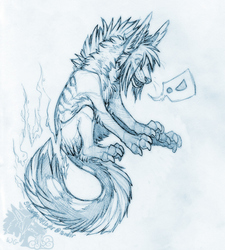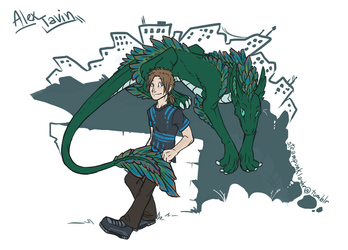Sign In
CloseReupload from 2013. Did a mini/quickref for foglizards, an original species of mine, along with some notes!
Foglizards are a large and somewhat uncommon dragon-esque species that inhabit high altitudes, generally among a mix of rocky and misty wooded terrain. They are typically solitary creatures, maintaining large patches of territory with somewhat fluid boundaries; though large and intimidating, foglizards are not usually overtly aggressive unless given reason to be. They are primarily piscivores, relying on their jagged maws to feed upon a variety of freshwater species found in mountain lakes and streams. Their claws are large and blunt, and used more for gaining traction among rocky outcrops (the large ‘thumb’-claws on their forefeet seem especially suited to this purpose) than for fighting or hunting. One of their more prominent features are the tough, stone-like crests along their backs, as well as the fog-like novoxic wisps trailing from their tails.Their coloration tends to mimic the rocky cliff-faces and outcroppings of their environment, coming in a variety of cool, mottled tones with faint striping on the tail and moth-like antennae (technically known as dusters).
A foglizard’s dusters are multipurpose- though biologists were initially aware of their function to convey emotions (alertness, aggression, submissiveness, etc) further findings indicated their role as sensory organs as well. These feathery appendages trap and analyze airborne molecules and pheromones, essentially allowing them to ‘smell’ whatever is on the breeze.
(Speculative biology time! In addition to their dusters’ role as scent-organs as opposed to your typical nostrils, foglizard’s respiratory systems are unique as well, or at least the entrance thereof. I am thinking they intake air from beneath those hard overlapping ‘plates’ on their necks; its one of the most protected places on their bodies, and this would also allow them to keep their actual heads submerged for long lengths of time waiting for tasty fish to come along. oAo)
Submission Information
- Views:
- 209
- Comments:
- 0
- Favorites:
- 5
- Rating:
- General
- Category:
- Visual / Digital




